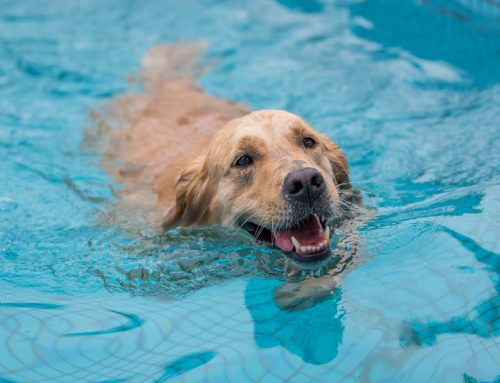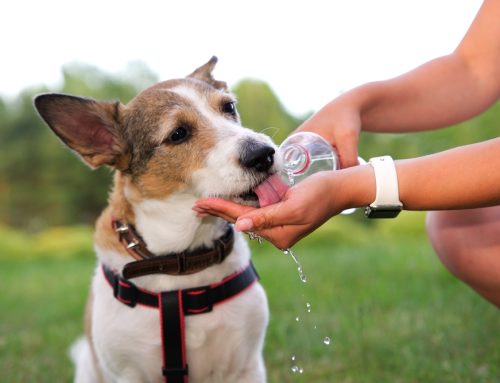Although your pet is outfitted in a plush fur coat, they can still develop frostbite and hypothermia in inclement weather. With average daytime winter temperatures hovering around the freezing mark, you need to keep your four-legged friend warm and safe when outdoors. Follow our MountainView Veterinary Hospital team’s top tips to keep your pet safe outdoors in cold weather.
#1: Deck out your pet in well-fitted outdoor gear
Before venturing outdoors in the winter, you bundle up in a coat, scarf, gloves, hat, and boots to stay warm and dry. While your pet has a fur coat to help keep them warm, they also need appropriate cold-weather gear to protect them from the harsh elements. A properly fitted waterproof jacket or vest is a great way to trap your pet’s body heat while repelling icy moisture that can leach away warmth.
When outfitting your pet for winter weather, remember to protect their paws too. Waterproof booties protect sensitive paw pads from snow, ice, and salt, keeping dogs’ feet free from cuts, scrapes, and chemicals.

#2: Keep your dog away from icy surfaces
If a teasing squirrel runs onto a frozen lake, keep your dog safely leashed by your side. Although the water may appear frozen solid, your four-legged friend may venture onto a weak spot and fall through. In addition, as you traverse sidewalks and pavements, keep an eye out for slick black ice. An overeager dog—remembering that taunting squirrel—can skid across unseen ice, potentially injuring themself and you. Keep in mind that as ice melts and refreezes, it can create sharp spikes and jagged edges that can cut your pet, especially their paw pads. When in doubt, walk through the snow or on clear sidewalks and pavements to avoid icy spots.
#3: Pay close attention to pets who have health conditions
Each pet handles cold weather differently. Puppies, kittens, and senior pets struggle to regulate their body temperature, and can become chilled more quickly than their robust adult counterparts. Pets with endocrine disorders, such as hypothyroidism or Cushing’s disease, also have a more difficult time staying warm. If your pet has arthritis, cold weather can exacerbate their condition, causing more pain and decreased mobility. If your pet has a health condition, usher them inside as quickly as possible after they have finished their business outdoors when winter weather is extreme.
#4: Keep your pet away from dangerous wintertime chemicals
Antifreeze toxicity is a serious concern for cats and dogs alike. Although cats are less interested in this sweet liquid than dogs, they can still be poisoned by taking a few laps of spilled antifreeze. Opt for pet-safe alternatives that contain propylene glycol—rather than ethylene glycol—and keep your furry pal out of the garage while winterizing your vehicle.
Salt and other deicing products can also be hazardous to pets. When clearing your outdoor walkways, use pet-safe salt to melt the ice. In addition, when your pet comes in after having been outside in wintry conditions, thoroughly clean their paws, legs, and belly to remove potentially dangerous chemicals’ last trace.
#5: Know frostbite and hypothermia signs in pets
Your pet’s extremities—tail, nose, ears, and paws—are most susceptible to frostbite. Although rarely life-threatening, frostbite can lead to hypothermia, which can be life-threatening. Pets’ frostbite signs include:
- Shriveled skin
- Initially pale skin that eventually become red and puffy
- Red or gray-tinged ears, tail, or nose
- Painful ears, tail, paws, or nose
- Ice crystallization around the nose
If your pet has frostbite signs, they can quickly develop hypothermia if they get wet from melting snow or ice. At the first concerning sign, head indoors to warm up your pet. Be on the lookout for the following hypothermia signs:
- Shivering
- Muscle stiffness
- Lethargy
- Difficulty walking
- Pale gums
- Disorientation
As your pet’s hypothermia progresses, they will stop shivering, collapse, and develop slow and irregular heart and breathing rates. Keep in mind that if the outdoor temperatures are too cold for you, the conditions are likely too cold for your pet. So, head back inside as soon as your four-legged friend completes their business.
#6: Create a safe and warm resting spot for your pet
Nothing feels better on a cold, blustery day than sitting in front of a blazing fire. However, prevent your inquisitive pet from venturing too close to the toasty-warm fireplace and getting burned. Block your pet’s fireplace access, and ensure they are not within popping embers’ reach. In addition, keep your pet away from space heaters, and avoid leaving these appliances running when you are not home. Set up your pet’s cozy napping place away from drafty doors and windows, and furnish the spot with fleece blankets for burrowing. Rather than using heating pads—from which your pet could develop burns—provide plenty of blankets and towels for warmth.
Prevent wintertime cabin fever from getting your pet down. By following our cold weather safety tips, you and your pet can enjoy some winter fresh air—if even for a short period. However, if your pet is exhibiting frostbite or hypothermia signs, or you would like additional cold weather safety tips, contact your Denville veterinarian at MountainView Veterinary Hospital.








Leave A Comment